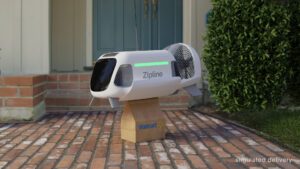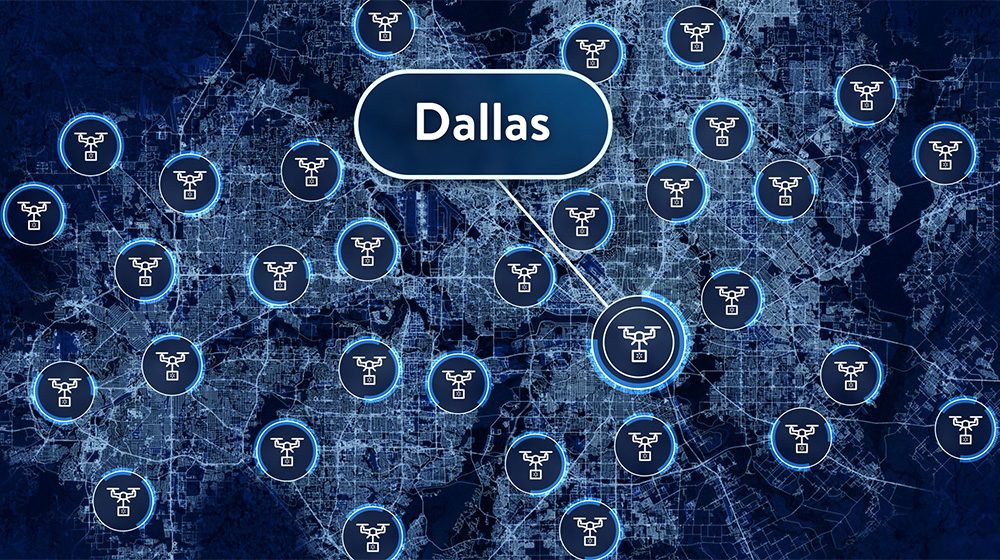 Walmart to expand drone delivery to 75% of homes in DFW area
Walmart to expand drone delivery to 75% of homes in DFW area
By DRONELIFE Features Editor Jim Magill
Walmart, which currently delivers products via unmanned aerial vehicles from several Texas locations, plans to expand its drone operation to cover three-quarters of the Dallas/Fort Worth (DFW) metroplex area by the end of the year.
On January 9, the retail giant announced that, in partnership with on-demand drone delivery providers, Wing and Zipline it would expand its UAV deliveries to its stores across more than 30 towns and municipalities in the DFW metroplex.
In a press release, Prathibha Rajashekhar, senior vice president, Innovation & Automation for Walmart U.S., said the program’s expansion would make a broad assortment of Walmart items available for delivery to customers’ homes within minutes. “Drone delivery is not just a concept of the future, it’s happening now and will soon be a reality for millions of additional Texans,” he said.
Both Wing and Zipline have received Federal Aviation Administration approval for beyond visual line of sight (BVLOS) flight, which is expected to enable drone delivery to more customers than ever before, the company said.

 Compared with conventional methods of over-land delivery, drone delivery gives customers a faster delivery option, getting items to them in 30 minutes or less, with some deliveries being accomplished in as short a time as 10 minutes.
Compared with conventional methods of over-land delivery, drone delivery gives customers a faster delivery option, getting items to them in 30 minutes or less, with some deliveries being accomplished in as short a time as 10 minutes.
Over the last two years of conducting drone deliveries on a trial basis, Walmart has completed more than 20,000 safe deliveries. Following the service expansion, participating store locations can offer drone deliveries within a radius of 10 miles. Customers within the drone delivery service area can place an order by visiting wing.com/Walmart or flyzipline.com/get-delivery.
In an interview, Jeff Williams, Zipline’s head of U.S. Operations, said that under its agreement with Walmart, the drone delivery company would initially perform “tens of thousands of validation flights, to ensure that the system that we have is as safe, fast, reliable and quiet as it should be.”
Later this year, following the completion of the validation flight phase, Zipline will move to a pilot phase in which it will begin to perform small-scale commercial deliveries to customers to observe how the system works in a real-world environment. Then the company will start to equip stores in the Dallas area with the Zipline platform, Williams said.
The Zipline system employs two vehicles, the primary aircraft, known as the Zip, and the smaller Droid, which fits in the belly of the Zip and which carries the payload of items to be delivered to the customer. The Zip, which is capable of flying vertically like a plane and hovering like a helicopter, is able to fly autonomously to service customers within a 10-mile radius of its home base store.
“The way the system works is, once we have your address and you’re onboarded as a customer, we align with the customer on a very precise delivery location for them, whether that is in the backyard or on the front porch,” Williams said.
Once it reaches its destination, the Zip will then hover hundreds of feet up above the delivery location and the Droid will be lowered to the drop zone on a tether. The Droid has its own quiet navigation system which allows it to land on the specific spot that’s been identified by the customer with a minimum of noise to disturb the neighbors. Once the delivery is complete the Droid is hoisted back up to the primary aircraft, which then returns to the dock to fulfill its next delivery, Williams said.
In order to increase operational efficiency, Zipline plans to employ a hub-and-spoke system, similar to those used by commercial airliners.
“What we’re looking to enable is a honeycomb or a network type of effect, where there doesn’t necessarily have to be one certain number of drones per store,” he said. “The droid, following its delivery, knows where it needs to go next, knows where the demand is, knows where the rest of the fleet is, so the system can autonomously pick up deliveries, drop deliveries off and charge as it needs to.”


In a blog post, Wing said its agreement with Walmart will expand a partnership it has had with the retail giant since last August, when it began deliveries to customers in the DFW area. The company currently operates out of two Texas Walmart stores in the metroplex, located in Frisco and Lewisville, reaching 60,000 homes.
“In our first four months of service, the response from Walmart customers has been overwhelmingly positive, using the service to order a range of products, including quick meals, groceries, household essentials, and over-the-counter medicines,” according to the post.
In 2019, Wing became the first drone delivery company in the United States to receive a Part 135 Air Carrier Certificate, allowing it to conduct flights within a 6-mile radius from its nests in the two towns. Wing’s latest environmental approval in the DFW metroplex marks the first time the FAA has approved an entire metropolitan area for drone delivery.
“Wing’s recent summary grant enables us to move toward BVLOS operations without visual observers across DFW and similar airspace surrounding other major U.S. cities,” the company said in its blog post. “This marks a paradigm shift in the way U.S. regulators are approaching approvals for these types of advanced BVLOS drone operations.”
In the Walmart statement, Wing CEO Adam Woodworth said that the first several months of delivering to Walmart customers paved the way for the partnership’s expansion. “Demand for drone delivery is real,” he said. “The response has been incredible from customers ordering drone delivery from Walmart every day, and it’s a testament to our partnership that we’re now expanding our footprint to bring this innovative delivery option to millions of Texans. If this milestone is any indication, we believe 2024 is the year of drone delivery.”
Read more:

 Jim Magill is a Houston-based writer with almost a quarter-century of experience covering technical and economic developments in the oil and gas industry. After retiring in December 2019 as a senior editor with S&P Global Platts, Jim began writing about emerging technologies, such as artificial intelligence, robots and drones, and the ways in which they’re contributing to our society. In addition to DroneLife, Jim is a contributor to Forbes.com and his work has appeared in the Houston Chronicle, U.S. News & World Report, and Unmanned Systems, a publication of the Association for Unmanned Vehicle Systems International.
Jim Magill is a Houston-based writer with almost a quarter-century of experience covering technical and economic developments in the oil and gas industry. After retiring in December 2019 as a senior editor with S&P Global Platts, Jim began writing about emerging technologies, such as artificial intelligence, robots and drones, and the ways in which they’re contributing to our society. In addition to DroneLife, Jim is a contributor to Forbes.com and his work has appeared in the Houston Chronicle, U.S. News & World Report, and Unmanned Systems, a publication of the Association for Unmanned Vehicle Systems International.
Miriam McNabb is the Editor-in-Chief of DRONELIFE and CEO of JobForDrones, a professional drone services marketplace, and a fascinated observer of the emerging drone industry and the regulatory environment for drones. Miriam has penned over 3,000 articles focused on the commercial drone space and is an international speaker and recognized figure in the industry. Miriam has a degree from the University of Chicago and over 20 years of experience in high tech sales and marketing for new technologies.
For drone industry consulting or writing, Email Miriam.
TWITTER:@spaldingbarker
Subscribe to DroneLife here.




